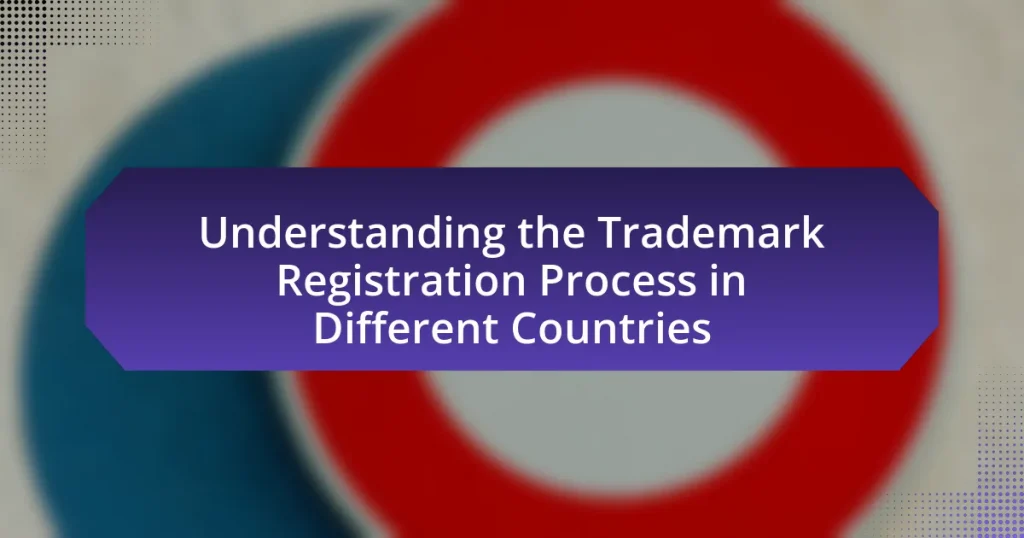Trademark dilution is the weakening of a trademark’s distinctiveness or reputation due to unauthorized use by others, even in the absence of consumer confusion. This concept is legally defined under the Lanham Act, which protects famous trademarks from dilution through blurring or tarnishment. The article explores the key elements of trademark dilution, its differences from trademark infringement, and the importance of protecting brand identity for businesses. It also discusses proactive measures companies can take to prevent dilution, the legal remedies available, and notable cases that illustrate the complexities of trademark law. Understanding trademark dilution is essential for maintaining brand integrity and competitive advantage in the marketplace.

What is Trademark Dilution?
Trademark dilution refers to the weakening of a trademark’s distinctiveness or reputation due to unauthorized use by others. This occurs when a similar mark is used in a way that diminishes the uniqueness of the original trademark, even if there is no likelihood of confusion among consumers. For example, the use of a famous brand name in a different market can still dilute its identity, as established in the Federal Trademark Dilution Act of 1995, which protects famous trademarks from such harm.
How is Trademark Dilution defined in legal terms?
Trademark dilution is defined in legal terms as the lessening of the capacity of a famous mark to identify and distinguish goods or services, regardless of the presence or absence of competition between the parties or the likelihood of confusion. This concept is primarily addressed in the Lanham Act, specifically under Section 43(c), which protects famous trademarks from uses that may dilute their distinctiveness or harm their reputation. The legal framework establishes that even non-competing uses can constitute dilution, emphasizing the protection of the mark’s uniqueness and value in the marketplace.
What are the key elements that constitute Trademark Dilution?
The key elements that constitute Trademark Dilution are the distinctiveness of the mark, the similarity between the marks, and the likelihood of dilution. Distinctiveness refers to how unique and recognizable a trademark is, which is crucial for establishing its protection under trademark law. The similarity between the marks involves assessing how closely the allegedly diluting mark resembles the famous mark, which can lead to confusion among consumers. Lastly, the likelihood of dilution examines whether the use of the similar mark diminishes the uniqueness or reputation of the famous mark, even in the absence of consumer confusion. These elements are foundational in legal cases concerning trademark dilution, as established in the Federal Trademark Dilution Act of 1995.
How does Trademark Dilution differ from Trademark Infringement?
Trademark dilution differs from trademark infringement in that dilution refers to the weakening of a trademark’s distinctiveness or reputation, while infringement involves unauthorized use of a trademark that causes confusion among consumers. Trademark dilution can occur even without consumer confusion, as it focuses on the impact on the brand’s uniqueness, whereas infringement specifically addresses the likelihood of confusion in the marketplace. For instance, the Federal Trademark Dilution Act of 1995 allows trademark owners to protect their marks from dilution regardless of the presence of confusion, highlighting the distinct legal frameworks governing these two concepts.
Why is Trademark Dilution important for businesses?
Trademark dilution is important for businesses because it protects the distinctiveness and reputation of their brands. When a trademark is diluted, it loses its unique identity, which can lead to consumer confusion and diminished brand value. For instance, a study by the International Trademark Association found that 75% of consumers associate strong trademarks with high-quality products, indicating that dilution can negatively impact consumer perception and sales. Therefore, safeguarding against trademark dilution is crucial for maintaining brand integrity and competitive advantage in the marketplace.
What potential risks does Trademark Dilution pose to brand identity?
Trademark dilution poses significant risks to brand identity by weakening the distinctiveness and recognition of a brand. When a trademark is diluted, it can lead to consumer confusion, as the association between the brand and its products or services becomes less clear. This confusion can diminish the perceived value of the brand, as consumers may struggle to differentiate between the original brand and others that use similar marks. A study by the International Trademark Association indicates that 75% of consumers believe that trademark dilution negatively impacts their perception of a brand’s quality. Consequently, trademark dilution can erode brand loyalty and trust, ultimately harming a company’s market position and profitability.
How can Trademark Dilution affect consumer perception?
Trademark dilution can negatively affect consumer perception by weakening the distinctiveness of a brand. When a trademark is diluted, consumers may struggle to associate the brand with its original quality or reputation, leading to confusion and diminished trust. For instance, a study by the International Trademark Association found that 70% of consumers believe that trademark dilution can lead to a decrease in the perceived value of a brand. This dilution can result in consumers perceiving the brand as less unique or credible, ultimately impacting their purchasing decisions and loyalty.

What are the types of Trademark Dilution?
There are two primary types of trademark dilution: blurring and tarnishment. Blurring occurs when a trademark’s distinctiveness is weakened due to its association with a similar mark, leading to confusion among consumers. Tarnishment happens when a trademark is linked to inferior or unsavory products or services, damaging the brand’s reputation. These types of dilution are recognized under the Lanham Act, which aims to protect the unique identity of well-known trademarks from unauthorized use that could harm their value.
What is Blurring in Trademark Dilution?
Blurring in trademark dilution refers to the weakening of a trademark’s distinctiveness due to its association with a different product or service. This occurs when consumers begin to associate the trademark with multiple sources, diminishing its ability to identify and distinguish the original goods or services. For example, if a well-known brand is used by various unrelated businesses, it can lead to confusion among consumers, ultimately eroding the brand’s unique identity. Legal frameworks, such as the Lanham Act in the United States, recognize blurring as a form of trademark dilution, allowing the original trademark owner to seek protection against such unauthorized uses.
How does Blurring impact the distinctiveness of a trademark?
Blurring diminishes the distinctiveness of a trademark by weakening the association between the mark and its source. When a trademark is used in a manner that causes it to become less unique, consumers may struggle to identify the original source of the goods or services associated with that mark. This can occur when similar marks are used on unrelated products, leading to confusion among consumers. For instance, a study by the Trademark Trial and Appeal Board highlighted that the use of a famous trademark on non-competing goods can dilute its distinctiveness, ultimately reducing its ability to signify a single source.
What examples illustrate Blurring in Trademark Dilution?
Examples illustrating blurring in trademark dilution include the use of famous trademarks in unrelated product categories, which diminishes the distinctiveness of the original mark. For instance, if a well-known brand like “Coca-Cola” is used for a line of clothing, it can create confusion and weaken the association consumers have with the beverage. Another example is the use of “Apple” for a non-technology-related product, which can dilute the brand’s identity associated with electronics. These instances demonstrate how the original trademark’s uniqueness is compromised, leading to potential consumer confusion and a loss of brand value.
What is Tarnishment in Trademark Dilution?
Tarnishment in trademark dilution refers to the harm caused to a trademark’s reputation when it is associated with inferior or unsavory products or services. This negative association can diminish the distinctiveness and value of the trademark, leading to a loss of consumer trust. For example, if a well-known luxury brand is linked to a low-quality or offensive product, it may suffer tarnishment, which can result in legal action to protect the brand’s integrity. The Lanham Act provides a legal framework for addressing such issues, emphasizing the importance of maintaining a trademark’s positive image in the marketplace.
How does Tarnishment harm a brand’s reputation?
Tarnishment harms a brand’s reputation by associating it with negative or unsavory products or services, which can lead to a decline in consumer trust and loyalty. When a brand’s image is linked to inferior or offensive offerings, it diminishes the perceived quality and value of the brand. For example, a luxury brand may suffer if its name is used in connection with low-quality counterfeit goods, resulting in a tarnished image that can deter potential customers. Research indicates that 70% of consumers are less likely to purchase from a brand that has been associated with negative publicity, highlighting the significant impact tarnishment can have on consumer perception and brand equity.
What are some notable cases of Tarnishment?
Notable cases of tarnishment include the case of Moseley v. V Secret Catalogue, Inc., where the Sixth Circuit ruled that the use of “Victor’s Little Secret” by a lingerie store tarnished the famous Victoria’s Secret brand. Another significant case is the Mattel, Inc. v. MCA Records, Inc., where the court found that the song “Barbie Girl” did not tarnish the Barbie brand, as it was deemed a parody rather than a negative association. Additionally, in the case of Louis Vuitton Malletier S.A. v. Haute Diggity Dog, LLC, the court ruled that the use of “Chewy Vuiton” by a pet toy company did not tarnish the luxury brand’s reputation. These cases illustrate the complexities of tarnishment in trademark law, highlighting the balance between brand protection and freedom of expression.

How can businesses protect against Trademark Dilution?
Businesses can protect against trademark dilution by actively monitoring and enforcing their trademarks, ensuring they are used correctly and consistently. This includes registering trademarks with the United States Patent and Trademark Office (USPTO) or relevant authorities, which provides legal recognition and strengthens the ability to defend against dilution claims. Additionally, businesses should engage in regular market surveillance to identify unauthorized uses of their trademarks and take swift legal action against infringers. According to the Trademark Dilution Revision Act of 2006, a trademark owner must demonstrate that their mark is famous and that the unauthorized use is likely to cause dilution, thus emphasizing the importance of maintaining the distinctiveness and reputation of the trademark.
What proactive measures can companies take to prevent Trademark Dilution?
Companies can prevent trademark dilution by actively monitoring and enforcing their trademarks, ensuring consistent branding, and educating employees about trademark rights. Regularly monitoring the marketplace for unauthorized use of trademarks allows companies to identify potential dilution early. Consistent branding across all platforms reinforces the distinctiveness of the trademark, making it less susceptible to dilution. Additionally, educating employees about the importance of trademarks and the risks of dilution fosters a culture of respect for intellectual property. These measures are supported by legal frameworks that protect trademarks, such as the Lanham Act in the United States, which emphasizes the need for proactive enforcement to maintain trademark strength.
How important is trademark registration in this context?
Trademark registration is crucial in the context of trademark dilution as it provides legal protection and exclusive rights to the trademark owner. Registered trademarks are easier to defend against dilution claims, as they establish a presumption of validity and ownership. According to the United States Patent and Trademark Office, registered trademarks can significantly enhance the ability to enforce rights and prevent unauthorized use, thereby reducing the risk of dilution.
What role does monitoring and enforcement play in protection?
Monitoring and enforcement play a critical role in the protection of trademarks by ensuring that trademark rights are upheld and violations are addressed. Effective monitoring allows trademark owners to detect unauthorized use or dilution of their marks, which can undermine brand value and consumer trust. Enforcement actions, such as sending cease-and-desist letters or pursuing legal action, serve to deter potential infringers and reinforce the legal protections afforded to trademarks. For instance, a study by the International Trademark Association highlights that proactive enforcement strategies significantly reduce instances of trademark infringement, thereby maintaining the integrity of the brand and its associated goodwill.
What legal remedies are available for Trademark Dilution?
Legal remedies available for trademark dilution include injunctive relief, monetary damages, and attorney’s fees. Injunctive relief allows the trademark owner to seek a court order to stop the diluting activity, preventing further harm to the brand. Monetary damages can be awarded to compensate for losses incurred due to dilution, and in some cases, profits made by the infringer can also be recovered. Additionally, courts may award attorney’s fees to the prevailing party, particularly if the case involves willful dilution. These remedies are established under the Lanham Act, which provides a legal framework for protecting trademarks from dilution.
How can businesses pursue legal action against Trademark Dilution?
Businesses can pursue legal action against trademark dilution by filing a lawsuit under the Lanham Act, specifically Section 43(c), which provides a federal cause of action for trademark dilution. To succeed, businesses must demonstrate that they own a famous mark, that the alleged dilution is occurring through the use of a similar mark by another party, and that this use is likely to cause dilution of the distinctive quality of the famous mark. Courts have established that dilution can occur through blurring or tarnishment, and businesses must provide evidence of the mark’s fame and the likelihood of dilution. Notably, the case of Moseley v. V Secret Catalogue, Inc. (2003) clarified the standard for proving dilution, emphasizing the need for actual dilution rather than merely a likelihood of dilution.
What are the potential outcomes of a Trademark Dilution lawsuit?
The potential outcomes of a Trademark Dilution lawsuit include injunctive relief, monetary damages, and the possibility of attorney’s fees being awarded. Injunctive relief may prevent the defendant from continuing the dilutive actions, thereby protecting the trademark owner’s rights. Monetary damages can compensate the trademark owner for any harm suffered due to the dilution, which may include lost sales or diminished brand value. Additionally, if the trademark owner prevails, courts may award attorney’s fees, particularly if the defendant’s actions are found to be willful. These outcomes are grounded in the Lanham Act, which governs trademark law in the United States and provides a framework for addressing dilution claims.
What best practices should businesses follow to mitigate Trademark Dilution risks?
To mitigate Trademark Dilution risks, businesses should actively monitor and enforce their trademarks, ensuring they are used correctly and consistently. This includes conducting regular audits of trademark usage in marketing materials and online platforms to prevent unauthorized use. Additionally, businesses should educate employees and partners about the importance of trademark protection and the potential consequences of dilution. Implementing clear brand guidelines can help maintain the integrity of the trademark. Furthermore, registering trademarks with the United States Patent and Trademark Office (USPTO) or equivalent authorities strengthens legal protection and provides a basis for enforcement against infringers. These practices are supported by legal precedents that demonstrate the effectiveness of proactive trademark management in reducing dilution risks.



